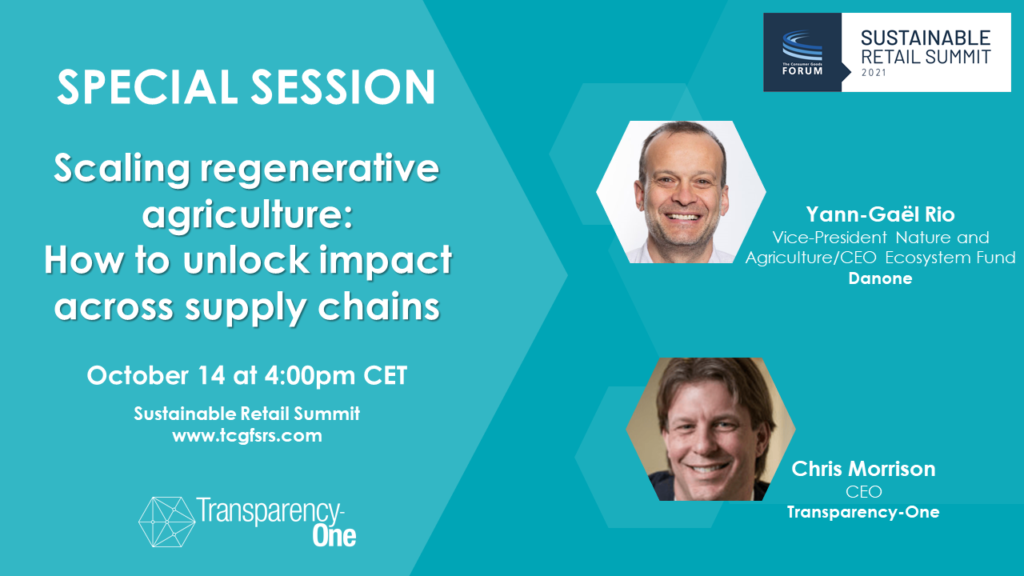This article was originally posted on The Consumer Goods Forum.
 The theme of this year’s Sustainable Retail Summit, “The Evolving Face of Sustainability: Acting Today to Shape Tomorrow,” encourages us to consider what actions we as businesses can take to build a more sustainable world.
The theme of this year’s Sustainable Retail Summit, “The Evolving Face of Sustainability: Acting Today to Shape Tomorrow,” encourages us to consider what actions we as businesses can take to build a more sustainable world.
The urgent moral need for sustainability is well known to anyone living in a world affected by climate change. But there is a clear business case as well. According to McKinsey, global sustainable investment now tops $30 trillion, a tenfold increase since 2004. In addition, “upward of 70 percent of consumers surveyed on purchases in multiple industries…said they would pay an additional 5 percent for a green product if it met the same performance standards as a nongreen alternative.” Simply put, prioritizing sustainability in business is profitable.
A more sustainable future starts with action today—but the process of developing a successful sustainability initiative is uncharted territory for many. How can organizations translate big-picture sustainability goals into concrete programs? What real and specific actions can organizations take to develop more sustainable and ethical supply chains? We see this as a three-step process.
Step 1: Define Your Starting Point
How do you prioritize where to begin given your organization’s resources, capabilities, and priorities?
Start by considering two key factors:
- Your organization’s goals and objectives. What sustainability claims and commitments has your business made? What marketing initiatives does your organization plan to implement? What are your areas of key risk? It is also essential to consider the needs and interests of other departments in your organization, such as procurement, as they play a critical role in scaling responsible sourcing across the business.
- Your specific supply chains of interest. Every supply chain is unique. To determine the best candidate, assess the size and potential impact of your supply chains of interest, sourcing countries and associated risks, and the readiness of suppliers to tackle sustainability initiatives. Your starting point will be found at the right intersection of maximum impact and risk reduction, supplier readiness, and your available resources.
Taking the time to determine the best starting point for your organization ensures that the resources and effort invested lead to beneficial business results—which in turn generates momentum for future programs.
Step 2: Determine What Data to Collect
What data, and from which suppliers, do you need to meet your specific needs?
The amount of supply chain data available is virtually limitless. But the goal should not be to capture all data, but rather, to capture the right data. Data collection should be done strategically and with a clear connection to your program’s objective.
Depending on your business goals, you may need to ask yourself:
- How does your company define “sustainable sourcing” or “social responsibility”? How, specifically, does this translate to action items for your suppliers?
- What consumer-facing claims is your company making, and what data will support these claims? What are consumers most interested in learning about?
- What data might you be missing to comply with certain regulatory requirements?
- What information do you need to build a robust resiliency plan?
Carefully consider the extent of your ask. Suppliers frequently juggle requests from customers and have limited time to invest in multiple client initiatives. To maximize success, determine what information is truly mandatory, how far down the supply chain you need to go to achieve your objective, and what level of engagement is needed from your suppliers at this time. This consideration will go a long way in ensuring your efforts are fruitful.
Step 3: Develop a Supplier Engagement Plan
What is the best way to communicate and engage with suppliers to maximize participation?
 Stakeholder participation is crucial for responsible sourcing. To encourage participation, communicating your project, objectives, and requirements with suppliers must be done thoughtfully.
Stakeholder participation is crucial for responsible sourcing. To encourage participation, communicating your project, objectives, and requirements with suppliers must be done thoughtfully.
First, approach the project as a collaboration, not a demand. Ambitious supply chain commitments typically require upending long-standing processes and implementing new capabilities, which can only be achieved through long-term collaboration.
In addition, address supplier concerns and questions upfront, such as how the program will be funded, how long it will last, how data will be kept secure, and the requirements for participation. By communicating the information suppliers want to know clearly and directly, you will increase understanding and set the stage for professional and respectful collaboration.
Measuring Success
How will you know if your sustainability efforts are truly successful?
The clearest metric for success is whether efforts to implement more sustainable and responsible sourcing result in concrete actions that improve the business. For this reason, the buy-in of other business units, procurement in particular, is essential to translate the findings of a program into specific changes in buying behaviors. Responsible sourcing programs must be incorporated across your entire business to have a real and lasting impact.
A strong commitment to sustainability and responsible sourcing has been proven to increase revenue and overall business success. As the demand for ethical and sustainable supply chains continues to grow, the ability to develop successful responsible sourcing programs becomes ever more important.
Real Business Case
What does responsible sourcing look like in action?
Join Yann-Gaël Rio, VP Nature and Agriculture at Danone, and Chris Morrison, CEO of Transparency-One, at the 2021 Sustainable Retail Summit for a Special Session on “Scaling regenerative agriculture: how to unlock impact across supply chains” on October 14 at 4:00pm CET.











